IJCRR - 11(9), May, 2019
Pages: 07-11
Date of Publication: 21-May-2019
Print Article
Download XML Download PDF
Analysing Potential Health Impacts of Drinking Water: A Case Study of Delhi Slums
Author: Ritika Prasad
Category: Healthcare
Abstract:New Delhi is home to about 17 million people. It is the largest Indian city in terms of area, and has the highest population density in the country. New Delhi has housed about 6,343 slums with approximately 1 million households. While the census indicates that 83% used treatedtap water as a primary potable water source, only half of the slum households have any water source within their housepremises, which reflects the insufficient availability and overreliance on unreliable shared sources. Provision of clean drinking water is vital to improving people's health and reducing the incidence of diseases and deaths. This drudgery is not only undesirable in itself but it also takes away other opportunities for self-development, productivity and income generation. Broken hand pumps and lack of piped connections results in women having to travel long distances to fetch water.
The aim of the paper is to examine the drinking water related health issues which are often faced by slum dwellers due to lack of sanitation facilities. The analysis of the paper has been carried out using primary survey of 100 respondents, 25 respondents from each surveyed slum and gathering secondary data from Delhi Jal Board and Central Pollution Control Board. The water from hand-pumps is considered non-potable and it is not recommended to be used for drinking and cooking purposes. This implies that the poor people in the slums, often without knowledge and ability to filter the supplied water, are the most vulnerable to receiving non-potable water and, hence, most vulnerable to water-borne diseases.
Keywords: Drinking water, Slums, Diseases, Health, Water borne
Full Text:
INTRODUCTION
Delhi, capital of India, is home to about 3 million people living in slums and it is estimated that 45% of its population lives in unauthorized colonies, JhughiJhopri (JJ) and urban villages.(Slum & JJ Department, Municipal Corporation of Delhi, 2009 Fact Sheet.)
As per the UN-HABITAT definition states ‘a slum household is a group of individuals living under the same roof in an urban area that lack one or more of the following
-
Durable housing of a permanent nature that protects against extreme climate conditions;
-
Sufficient living space which means not more than three people sharing the same room;
-
Easy access to safe water in sufficient amounts at an affordable price;
-
Access to adequate sanitation in the form of a private or public toilet shared by a reasonable number of people;
-
Security of tenure that prevents forced evictions.
Many of the health problems in urban slums stem from the lack of access to or demand for basic amenities. Basic service provisions are either absent or inadequate in slums. Poor living conditions, lack of income and scarce education contribute to serious health problems that would otherwise be preventable. Maternal health is poor, and death associated with pregnancy and childbirth is common as women have no access to suitable facilities or trained midwives.
The provision of a reliable supply of potable water must go hand-in-hand with the provision of a waterborne system of sewage disposal if there is to be any significant improvement in the health of the urban poor in the cities of the developing world. In the past, investment in urban sanitation lagged behind the provision of water supply and there was a tendency to promote the use of appropriate technological solutions in the form of on-site sanitation. In densely populated urban areas this is inappropriate because their discarded sludges, effluents and leachates will bring about gross pollution of groundwater and surface water resulting in conditions that pose a severe threat to health. (Reference: 'And Not a Drop to Drink': Water and Sanitation Services to the Urban Poor in the Developing World, Harry Giles and Bryan Brown).
Provision of clean drinking water is vital to improving people’s health and reducing the incidence of diseases and deaths. Women and girls spend hours fetching water. This drudgery is not only undesirable in itself but it also takes away other opportunities for self-development, productivity and income generation. (Reference:Examining Water Quantity and Quality in Delhi, India, Dr. David MaidmentNishtha Mehta)
It is commonly found that the drinking water quality in the slums are bad after the water quality analysis, and the water supply, none to very sporadic. Broken hand pumps and lack of piped connections results in women having to travel long distances to fetch water. The water from hand-pumps is considered non-potable and it is not recommended to be used for drinking and cooking purposes. This implies that the poor people in the slums, often without knowledge and ability to filter the supplied water, are the most vulnerable to receiving non-potable water and, hence, most vulnerable to water-borne diseases.
Water-borne diseases are "dirty-water" diseases those caused by water that has been contaminated by human, animal, or chemical wastes. Water-borne diseases include cholera, typhoid, polio, meningitis, and hepatitis A and E. Human beings and animals can act as hosts to the bacterial, viral, or protozoal organisms that cause these diseases. Where proper sanitation facilities are lacking, water-borne diseases can spread rapidly. Untreated excreta carrying disease organisms wash or leach into freshwater sources, contaminating drinking water and food.
Diarrheal disease, the major water-borne disease, is prevalent in many slum areas of the world where sewage treatment is inadequate. Using contaminated sewage for fertilizer can result in epidemics of such diseases as cholera. These diseases can even become chronic where clean water supplies are lacking.These kinds of health problems in adults and children though considered to common ailments lead to physical (pain, suffering, fatigue) mental (agony, distress and distraction) and financial losses (in terms of livelihood/ employment days and expenses on treatment). This disease burden is borne disproportionately by the slum dwellers.
The water in slums was often stored in open buckets kept on the floor without a ladle to draw it .This implies that the storage conditions can result in severe contamination and health risks. This also indicates a lack of access to safe water and water storage facilities affects the urban poor in slums significantly. The pollution is not simply restricted to the stored water but is a large part of the water source – river Yamuna.
THE STUDY AREA
Delhi, with a population of 17 million, is the third largest, fastest growing and most densely populated city in India. It has over 3 million living in slum colonies or slum like conditions, proliferating rapidly and lacking even the most basic amenities like water and sanitation. Migration has roughly averaged 1.3 times the natural growth in Delhi. The city has witnessed an increase of population at a phenomenal rate of 4.6% annually, double of the national average of 2.34% and more than the urban growth rate of any city of the country. The density of population, 11,297 persons per sq. km., as per Census 2011, is the highest in the country.
As Delhi swells due to a large influx of migrants from smaller cities, towns and rural areas, with unmatched provision of housing and basic amenities, ‘informal settlement’ increases in numbers, sizes and densities. Within Delhi four slum areas have been studied, Jagdamba slum camp in the south of Delhi, Lalbagh Jhuggi in the north of Delhi, Seelampur slums in the east and Amar Park Jhuggi in the west of Delhi. (Reference: A report on Basic Services in Urban Slums of Delhi, March 2008.)
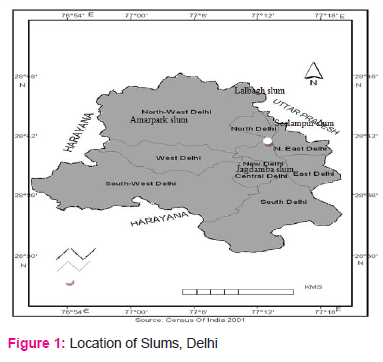
RESEARCH METHODOLOGY
The analysis of the paper is based on both primary and secondary data. Primary data was gathered by interviewing the slum respondents and government officials using structured questionnaire. The entire study has conducted a primary survey of 100 respondents selected randomly, 25 each from the four slums of Delhi. Questions were also prepared for the nearby government hospitals/clinics that the respondents visit when they suffer from health problems. In the survey it was the females who were mostly questioned. They were mostly between the age group of 18-35 years. Secondary data was gathered from Central Pollution Control Board (CPCB) and Delhi Jal Board.
CPCB is a statutory organisation under the Ministry of Environment, Forest and Climate Change (MoEF& CC). It was constituted in September, 1974 under the Water (Prevention and Control of Pollution) Act, 1974. Further, CPCB was entrusted with the powers and functions under the Air (Prevention and Control of Pollution) Act, 1981. The principal functions of CPCB is to promote cleanliness of streams and wells in different areas of the states by prevention, control and abatement of water pollution, and to improve the quality of air and to prevent, control or abate air pollution in the country
The Delhi Jal Board (DJB) is entrusted with the responsibility of procurement and distribution of water as well as treatment and disposal of sewage in study area of Delhi.DJB serves a total population of nearly 14 million through 1.47 million water connections. Delhi Jal Board was constituted through an Act of Delhi Legislative Assembly on 6th April 1998.
RESULTS AND DISCUSSION
Water Borne Diseases in the Slums
Looking into the slum wise water related diseases, all the sampled slums had almost the same health problems. In the Jagdamda slum camp of south Delhi the health problems which mainly prevailed due to unsafe drinking water were, diarrhoea, typhoid and jaundice. The irregular arrival of water tanker was mainly common in the Lalbagh slum of north Delhi. When the tank of water does not arrive the drinking water is stored for 2-3 days as a result of which the water gets contaminated and giving rise to the health problems. The people of Lalbagh slum also suffered with the same health problems related to drinking water as in case of Jagdamba slum. In the Seelampur slum and Amar Park jhuggi there was incidences of diarrhoeal diseases the most. Water in these two slums had bacteriological contamination as the ground water is hard. Usually the respondents told us the symptoms of the disease like fatigue, fever and cough. The diseases were confirmed from the nearby hospital which the slum people visited. There were 2-3 cases of deaths in Seelampur slums due to water borne diseases four years back. There were few also cases of cholera reported from the slum of Lalbagh.
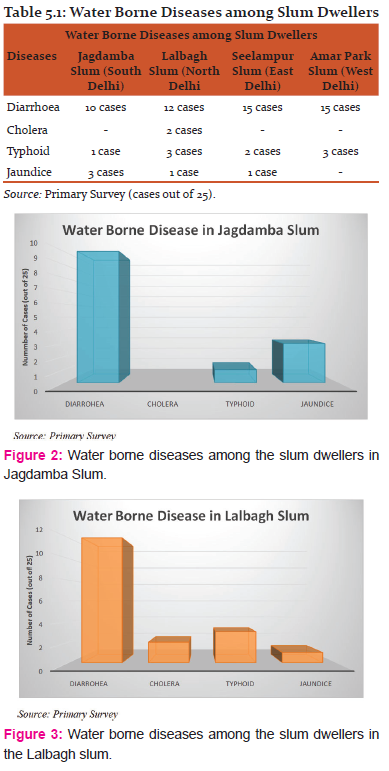
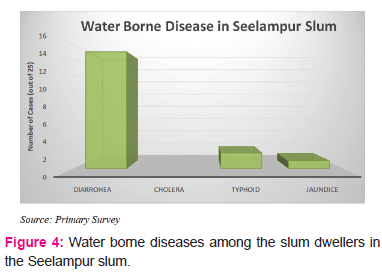

In order to confirm the data on health issues the study also collected information from the nearby hospitals and clinics which the slum dwellers visited when they suffer from the above given diseases. In the Jagdamba slum most of the slum dweller went to the nearby Madan Mohan Malviya government hospital for their treatment and private doctors. Though coming from the lower income group they had to get themselves treated by private doctors because some respondents say that they did not get proper attention in government hospital and had to wait long hours for their turn. In Seelampur slum the people went to the nearby Bhim Sen government hospital in Shastri Park. Some of them were also treated by private doctors in their locality. In Lalbagh slum there was a bangali doctor in the area where some of the people got themselves treated it was mainly because it costs less and was not far away rather located in the slum itself. Some respondents told that they also went to the Hindu Rao government hospital. In the Amarpark jhuggi, the slum people go to charitable dispensary in Motinagar.
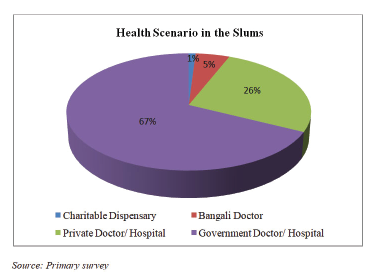
Fig 6: The health scenario shows that around 67 percent of the slum households go to government doctors/hospitals for treatment while 26 percent refer private practitioners/hospitals. Some of them also prefer Bangali Doctor and dispensary.
Study also made an effort to assess the frequency of treatment. Overall, in the slums around 10 percent of the cases respondents reported visiting the doctor 2-3 times a month and in around 25 percent of the households respondents reported visiting the doctor only once a month and 55 percent of the respondents did not visit the doctor often.
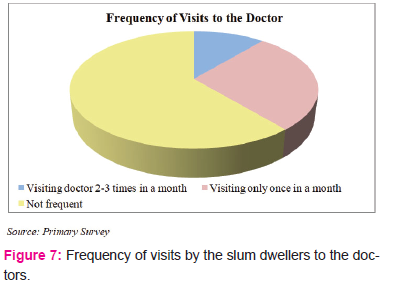
Fig 7: Frequency of visits by the slum dwellers to the doctors.
In the study it was also found that cases of water-borne diseases are reported throughout the year in the hospitals but during rains, people are more prone to these water borne diseases. At this time of the year, one can find contaminated water all around. Monsoons may have brought relief from Delhi's scorching heat, but on the flipside temperatures are rising with the onset of various diseases. Most hospitals witness a sudden rise in number of patients complaining of problems like diarrhoea, typhoid, jaundice etc.
CONCLUSION
The drinking water health issues mainly resulted from to contamination of water due to inadequate storage facilities, storing water for a longer period and not adopting various purification methods. In the sampled slums it was observed that diarrhoea was common disease in all the slums followed by cholera typhoid and jaundice. The incidences of diarrhoea are maximum due to lack of clean potable water especially in monsoons. Partly can be the reasons such as open drains and improper sewage facilities. Other water borne diseases result from also occur due to lack of access to safe water and water storage facilities and where sewage treatment is minimal. The slum dwellers visit the nearby health centres for their check-up there was no health centre and medical shop located within the slum area. This is one the main reasons which can be attributed to less frequent visits to the doctors when fallen ill as people have to devote almost their entire day. In the study it was also found that cases of water-borne diseases are reported throughout the year in the hospitals but during rains, people are more prone to these water borne diseases.
Having understood the gravity of the situation and the worldwide phenomenon of depleting water resources, it is imperative to put into practice strategies and activities for water management. Management of water not only requires a community based approach but also practices at individual level.
ACKNOWLEDGMENT
The author acknowledges the immense help received from the scholars whose articles are cited and included in references of this article. The author isalso grateful to authors / editors / publishers of all those articles, journals and books from where the literature for this article has been reviewed and discussed.
References:
-
R. N. Sharma and K. Sita. Cities, Slums and Government. Economic and Political Weekly, Vol. 35, No. 42 (Oct. 14-20, 2000), pp. 3733-3735
-
Rajiv Bahl, Pratima Ray, Swati Subodh, Prashant Shambharkar, Manju Saxena,Umesh Parashar, Jon Gentsch, Roger Glass, M. K. Bhan. The Journal of Infectious Diseases, Vol. 192, Supplement 1. Rotavirus in Asia: Epidemiology, Burden of Disease, and Current Status of Vaccines (Sep. 1, 2005), pp. S114-S119
-
How the 'Other Side' of Delhi Lives. Economic and Political Weekly, Vol. 23, No. 43 (Oct. 22, 1988), p. 2193
-
Statement on National Health Policy: Ministry of Health and Family Welfare, Government of India, New Delhi, 1982. Journal of Public Health Policy, Vol. 7, No. 2 (Summer, 1986), pp. 248-264.
-
Harry Giles and Bryan Brown. 'And Not a Drop to Drink': Water and Sanitation Services to the Urban Poor in the Developing World. Geography, Vol. 82, No. 2 (April 1997), pp. 97-109.
-
Planning Commission 2002, Water Supply and Sanitation – a WHO_UNICEF sponsored study, India-Assessment 2002, Planning Commission, Government of India, New Delhi, November 200, p 37.
-
Anon 2003, Health Information of India, 2000 and 2001, Central Bureau of Health Intelligence, Ministry of Health and Family Welfare, Government of India, p 182
-
Pande Suchi. Background note on health in urban slums in Delhi. Ensuring public accountability through community action 2005 Institute of Social Studies Trust, New Delhi
-
A Report - Drinking water and Sanitation status in India – Coverage Financing and Emerging Concerns, Water Aid India, 2005.
-
Sabir Ali (2003), Environmental Situation of Slums in India; especially Chapter 3 on the ‘Magnitude of Slum Problem in Delhi’. Uppal Publishing House, New Delhi.
-
Gita DewanVerma (2002): ‘Slumming India—A Chronicle of Slums and Their Saviours’. Penguin Books, India
-
Justin DeNormandie and Janette Sunita. Combating diarrhoeal disease in India through safe drinking water. Population Services International (PSI) Delhi, India November 2002.
-
Zerah, M. H. (2000). Water: Unreliable Supply in Delhi. New Delhi: Manohar Publishers.
-
Lal, P; et al., (1996). Incidence of diarrhoea and some related environmental and behavioural factors in Jhuggis of Delhi. Indian Journal of Public Health. Vol 40 (2).
-
Rehman, A and Netzband, M. 2007. An assessment of urban environmental issues using remote sensing and GIS techniques an integrated approach: A case study: Delhi, India. Paper presented in PRIPODE Conference - Urban Population, Development and Environment Dynamics in Developing Countries, Nairobi. 11th to 13th June, 2007.
-
Slum & JJ Department, Municipal Corporation of Delhi. (2009). Fact Sheet.
-
A report on Basic Services in Urban Slums of Delhi, March 2008.
-
Water Quality of Sub-standard Settlements in Delhi Hazards Centre 2006
|






 This work is licensed under a Creative Commons Attribution-NonCommercial 4.0 International License
This work is licensed under a Creative Commons Attribution-NonCommercial 4.0 International License